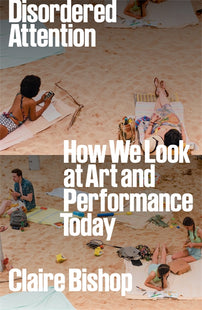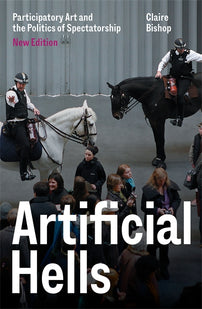Verso Book Club: Disordered Attention
Disordered Attention: How We Look at Art and Performance Today by Claire Bishop is one of our Verso Book Club June reads.

Should you be allowed to use a mobile phone in an art gallery? This is a question that divides critics as well as art snobs. The objections are variable: they get in the way. They intermediate a direct experience of the work, in the moment. They are only there for the likes. Undoubtedly, whatever the arguments about the audience and their phones, new technology has changed the way art is made, and the ways artists engage with their viewers. These are the kind of questions that the inestimable Claire Bishop asked in her new book Disordered Attention. In short, the book is the most insightful guide to how to understand art in the 21st century.
And it concerns attention:
Today I switch rapidly between different modes of attention. In a typical visit to an exhibition, I’ll get lost in long periods of focus and presence. But I’ll also scan the QR code to read the exhibition booklet later. I wonder if I can ask the curator for a link to stream the video at home. I take installation shots and a few close-ups. I respond to my part- ner’s texts about childcare. I photograph the labels. I send an image to a friend and tell them they were right, this is (or is not) a good show. This perpetual oscillation between here and elsewhere, consuming and commenting, is central to how we look at art and performance today.
Claire Bishop needs no introduction. Just last month she was named a Guggenheim Fellow in Fine Art Research. Her day job is Professor of Art History at CUNY Graduate Center in New York. Her first book, Artificial Hells, came out in 2012 and was reissued last year. It is one of the most important pieces of art writing for the last decade or so, putting the political claims of participatory art and relational aesthetics into the crosshairs. Too often we see this as an uncritical good; but it’s complicated, she concludes. We should be careful not to conflate political good intentions with aesthetic qualities. We must think harder here and be more critical and reflexive.
In Disordered Attention, Bishop again refuses to come up with easy answers. Thank god! She begins with the extraordinary work, Sun and Sea (Marina) that was first shown at the Venice Biennale in 2019 (it is also pictured on the book’s front cover). Located in a vast naval shipyard that had been turned into a beach, the opera/performance lasted 8 hours and included a cast of sunbathers, children, and a dog. At that length, no viewer was expected to watch the duration of the thing. Nor were the cast expected to perform for the total duration. But it was perfect for IG and twitter (X), without the expectation of capturing the whole. Activity is happening in all corners of the event. There is no narrative apart from the harmony of the chorus. That year the piece won the highest accolade, the Lion D’Or, but also the bragging rights for the most shared on social media. Every spectator, their own documentary maker. People captured the scene almost as if to say - I was there. But does this trivialize the experience? How does the artwork exist without the audience?
It is attention, rather than technology on its own, that has changed for us. And also in tow: distraction, hyper-attention, attention disorders, and care. As Claire wittily notes: The rise of an attention economy and its flipside, attention deficit hyperactivity disorder (ADHD), form the contextual horizon for this book. We are what we pay attention to. Previous generations have been defined by ‘masterworks’. As our attention becomes increasingly disordered, it becomes more difficult to make those kinds of moves.
With this in mind, the book takes on two big ideas: what is contemporary art? And an this be periodised? And if so, how is it to be characterised? And secondly, what are the key new forms of expression that have emerged from this conjuncture. These often appear to be forms that outwardly eschew technology, but it is impossible not to see them without this context.
Bishop pulls no punches. Research-based art, which first emerged in the 1990s, can reveal the investigative powers of art, but - at its worst - can look like a PhD student discovering Google. The vast amount of text means that the viewer is likely to skim or sample the work. The use of the museum or gallery space for dance - or an Opera - demands a looping and refreshed attention: one that is experienced in the moment, but also via networks. Protest art does not exist at all without mediation. There is No Pussy Riot, or P A I N’s event in the Guggenheim unless it is then recorded and distributed, in search of virality. Finally, the increased use of modernist architecture as a background to many new works, which by its repetition offers a scrolling attention.
Bishop’s point goes beyond what goes on in our museums and rarified enclaves. The way we make art, observe it, and find a place for it within our lives - the ways we pay attention - reflects something deeper about ourselves and our relation to the world. And how this is changing at an uncharted pace. Disordered Attention should not be skimmed, digested, fileted for the good bits, extracted or abandoned - it demands and deserves your fullest engagement. It is also filled with images and insights into an array of contemporary artists that you should know about.
I do hope that you enjoy this Verso Book Club selection.
Leo Hollis, Editorial Director
London, September 2023
Disordered Attention: How We Look at Art and Performance Today by Claire Bishop is one of our June Verso Book Club reads. Learn more about the Verso Book Club.
[book-strip index="1" style="buy"]


